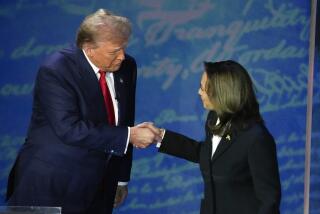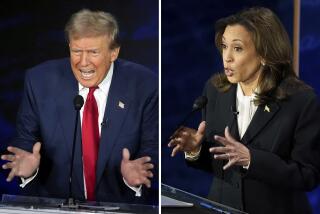TV dominates debate coverage but ‘dual-screeners’ on rise
A new-media company with a plucky name promised to deliver “real time” reaction to the first presidential debate. The techies would tabulate reaction “tapped” into handheld devices, instantly measuring how Mitt Romney and President Obama performed.
That all seemed 21st century groovy, until the results came in. Obama had “won” the debate, according to something like 70% of the handheld screen tappers. Scientific polls with some statistical significance showed quite the opposite.
It should probably come as no surprise, then, that a new survey by the Pew Research Center for the People and the Press shows that -- as much as Americans have begun to seek out new platforms to watch presidential debates -- the tried-and-true television set still predominates. And -- despite the obsessing of politicos via Twitter and Facebook -- only a small minority of real voters share their feelings about the showdowns via social media.
PHOTOS: Memorable presidential debate moments
A minority of 11% of debate watchers have adopted “dual screen” viewing habits — following last week’s first presidential debate on both a computer or mobile device and on television.
An even smaller percentage shared their feelings about the debate via social media. About a third of those who followed the debate online – representing 5% of the overall audience – reported sharing their reactions online. Among those under 40, there were more online sharers — 8%.
This is just a guess, but -- with myriad TV ads, emails, texts and brochures flying at them day after day -- voters may put a premium on the debates as one of the few moments when they can get a pure, unfiltered look at the two men fighting for the Oval Office. The 90-minute debate sessions remain somewhat sacrosanct — Americans taking the measure of Obama and Romney while quieting all the other inputs.
That’s not to say voters don’t continue to seek out additional information from multiple platforms. The same Pew survey -- of 1,006 Americans interviewed Oct. 4-7 — showed that more than a third of Americans got some debate information from online or social networking sites. More than half of those under 40 used those sources.
Traditional sources — television, newspapers and radio — remained go-to sources for the vast majority of Americans —78%, according to the survey. Change is clearly on the way, but old habits -- and the urge to spend a bit of quiet time alone with the next leader of the Free World -- also has a powerful allure.
Follow Politics Now on Twitter and Facebook
MORE COMMENTARY FROM JAMES RAINEY
Debate moderator “Silent Jim Lehrer” gets one last turn
Presidential debate: Round 1 goes to Romney, by many measures
Romney on a roll? Remember John Kerry, in debate, beat George W. Bush
More to Read
Get the L.A. Times Politics newsletter
Deeply reported insights into legislation, politics and policy from Sacramento, Washington and beyond. In your inbox three times per week.
You may occasionally receive promotional content from the Los Angeles Times.











